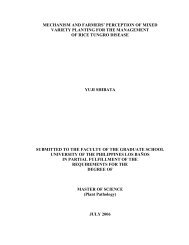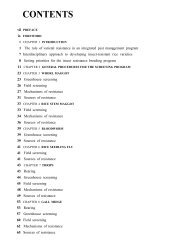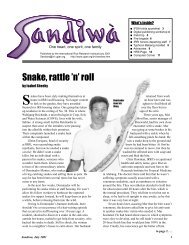Untitled - International Rice Research Institute
Untitled - International Rice Research Institute
Untitled - International Rice Research Institute
You also want an ePaper? Increase the reach of your titles
YUMPU automatically turns print PDFs into web optimized ePapers that Google loves.
→<br />
d<br />
e<br />
a<br />
e<br />
b<br />
d<br />
e<br />
d<br />
d<br />
e→<br />
c<br />
Fig. 11. Habit character of Bipolaris oryzae (Breda de Haan) Shoem. on (a) whole seed (10X), (b) sterile lemmas<br />
(40X), and (c) awn portion (40X). Photomicrograph of B. oryzae showing (d) conidiophore and (e) conidia at 10X and<br />
40X.<br />
Observed frequency (%)<br />
40<br />
30<br />
20<br />
10<br />
0<br />
Sterile<br />
lemmas<br />
Awn<br />
Partition<br />
bet. lemma<br />
and palea<br />
Entire<br />
seed<br />
Lemma/<br />
palea<br />
only or<br />
both<br />
Seed part<br />
Fig. 12. Observed frequency of Bipolaris oryzae<br />
occurrence on the seed.<br />
Fig. 13. Plate cultures of Bipolaris oryzae (Breda de<br />
Haan) Shoem. showing colony growths on PDA, PSA,<br />
and MEA incubated at ART, 21 °C, and 28 °C at 15 d<br />
after inoculation.<br />
plate. At 21 °C under alternating 12-h NUV light and<br />
12-h darkness, colonies spread moderately fast and<br />
attain a 4.62-cm diam in 5 d. They are fluffy, zonated<br />
with sinuate margins, and dark olive gray with olive<br />
gray mycelial tufts and 4-mm grayish advancing<br />
mycelia. The colony appears slightly zonated to zonated,<br />
black, and becomes dark olive gray outward on<br />
the reverse side of the agar plate. At 28 °C under<br />
alternating 12-h fluorescent light and 12-h darkness,<br />
colonies grow fast and attain a 5.10 cm diam in 5 d.<br />
20








